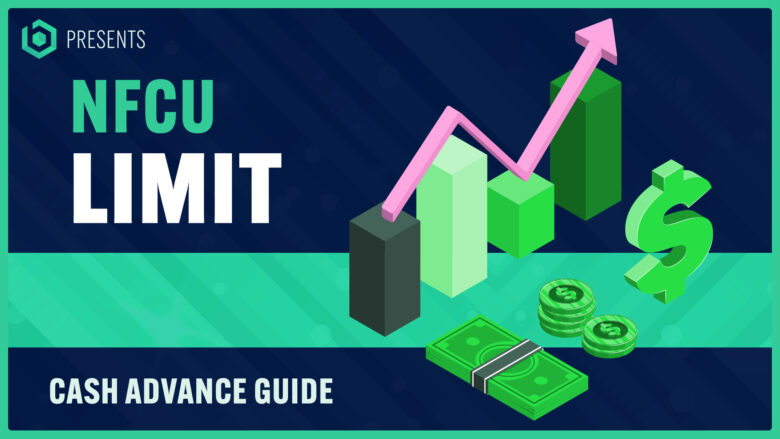Struggling with unexpected expenses or finding yourself in a financial bind can be stressful, but navigating your options for quick cash shouldn’t be. One such option is the Navy Federal Credit Union (NFCU) cash advance, allowing you to access funds when needed.
In this blog, we’ll dive into what you need to know about NFCU’s cash advance limit, its pros and cons, and available alternatives that may better suit your needs.
- Navy Federal Credit Union (NFCU) offers cash advances to its credit card holders, allowing them to access a small portion of their available credit as cash.
- Cash advance limits from NFCU vary depending on several factors, including cr, edit score, credit history, income level, existing debt, card usage, and account type.
- While NFCU cash advances can provide quick access to emergency funds, they come with high fees and interest rates. Customers should weigh the risks and costs associated with this option before making decisions.
- Alternatives to NFCU cash advances include personal loans, balance transfer credit cards that have lower interest rates than advances; overdraft protection programs offered by the bank; or alternative financial services like PockBox or Chime’s SpotMe that offer no-interest quick loan options up to $500.
Does Navy Federal Credit Union Offer Cash Advances?

Yes, Navy Federal Credit Union (NFCU) does offer cash advances to its credit card holders. This financial service allows you to access a small portion of your available credit as cash, making it useful for emergencies or situations where other payment methods may not be accepted.
To obtain a cash advance from NFCU, there are several options available. You can transfer funds online from your NFCU credit card directly into your Navy bank account by using the mobile app or online banking services.
Another option is to withdraw the desired amount through an NFCU ATM using your personal identification number (PIN).
It’s important to note that fees and higher interest rates are associated with credit card cash advances compared to regular purchases made with the same card. Interest on these transactions begins accruing immediately without any grace period, which means costs add up quickly if you don’t repay the borrowed amount promptly.
Navy Federal Credit Union (NFCU) Cash Advance Limit
Please find out how much cash you can get with your NFCU credit card through their cash advance limit, which varies depending on several factors, including your credit limit and available credit.
Factors Affecting Cash Advance Limits
Understanding the factors affecting your cash advance limits can help you make informed decisions when considering a cash advance from Navy Federal Credit Union. Here are some of the critical factors critical could impact your cash advance limit:
- Credit score: A higher credit score may result in a higher cash advance limit, as it indicates for the lender.
- Credit history: Your credit history, including payment history and outstanding debt, can significantly determine advance limits.
- Income level: A higher income could contribute to a higher cash advance limit, suggesting you have more resources available to repay the borrowed funds.
- Existing debt: If you already have substantial outstanding debt, this could negatively affect your cash advance limit.
- Card usage: Frequent use and responsible management of your NFCU credit card could increase your cash advance limit over time.
- Account type: The specific NFCU credit card or account you hold may influence the maximum amount available for cash advances.
It’s worth noting that each financial institution has its policies and guidelines for determining cash advance limits, so these factors may vary depending on where you bank with NFCU. To learn more about how these variables might apply to you and if there is any scope for increasing your NFCU Cash Advance Limit, consider contacting their customer service team or accessing online resources such as myFICO Forums or NerdWallet for further guidance.
How To Find Your NFCU Cash Advance Limit
Finding your Navy Federal Credit Union (NFCU) cash advance limit can seem daunting but with th. Still, with information and steps, you can carmine your limit and make informed decisions. Here’s how:
- Check your credit card statement: Your cash advance limit is usually mentioned on your monthly credit card billing statement along with other account details.
- Login to your NFCU online account: Navigate to the “Account Services” section, where you might find information about your cash advance limits.
- Refer to Cardholder Agreement: Your initial cardholder agreement should contain essential details about the terms, including cash advance limits.
- Use NFCU mobile app: Download and use the official NFCU mobile app to access all essential account-related information, including cash advance limits.
- Contact customer support: If you’re still unsure about your cash advance limit, contact Service for assistance and clarification.
Remember that it’s essential to keep track of these limits and use cash advances wisely; excessive cash advances can lead to high-interest rates and fees and negatively impact your credit score.
Pros And Cons Of NFCU Cash Advances

Cash advances can provide immediate access to funds for emergencies or unexpected expenses, but they come with risks and costs. One benefit of NFCU cash advances is that they can be transferred directly to a Navy bank account, making it easier to access the funds.
However, cash advance fees and high-interest rates make them more expensive than other financial solutions like personal loans or balance transfer credit cards.
Benefits Of Cash Advances
As a cash advance user, I understand this option isn’t always the best way to manage finances due to high fees and interest rates. However, there are some benefits to using cash advances in certain situations:
- Quick Access to Emergency Funds: Cash advances can provide quick access to necessary funds when unexpected expenses arise, such as a car repair or medical bill.
- No Credit Check Required: Since cash advances are a form of borrowing against your credit limit, no credit check is required for approval.
- Convenient: Cash advances can be obtained easily from ATMs or financial institutions.
- Suitable for Small Transactions: Cash advances can be helpful for small transactions such as buying groceries or filling up gas when you don’t have enough funds in your bank account.
- Foreign Currency Exchange: If you are traveling overseas and need local currency quickly, using a credit card cash advance can be a convenient and safe option to get foreign currency without carrying large amounts of cash.
Remember – while these benefits may seem appealing, weighing the risks and costs associated with cash advances before deciding if it’s the right choice is essential.
Risks And Costs Associated With Cash Advances
As a cash advance user, it is essential to essentially the risks and costs associated with this type of transaction. Here are some key things to keep in mind:
- High-Interest Rates: Cash advances typically have higher interest rates than regular credit card purchases.
- Cash Advance Fees: You may be charged a cash advance fee for each transaction, which can arrange the amount advanced.
- No Grace Period: Unlike regular credit card purchases, there may be no grace period for cash advances, meaning interest starts accruing immediately.
- Debt Cycle: If you rely too heavily on cash advances, you may be caught in a debt cycle that can be difficult to break.
- Credit Score Impact: Frequent or significant cash advances can negatively impact your credit score and make it more difficult to obtain credit in the future.
By understanding these risks and costs, you can make informed decisions about when and how to use cash advances as part of your overall financial strategy. It’s essential to weigh the benefits against the potential downsides before making any decisions.
Alternatives To NFCU Cash Advances

Instead of relying on cash advances from Navy Federal Credit Union, there are several alternatives you can consider. From personal loans to balance transfer credit cards and overdraft protection programs, these options can help you avoid the high fees and interest rates associated with cash advances.
Personal Loans
Another option to consider instead of taking out a cash advance from Navy Federal Credit Union is getting a personal loan. Personal loans typically offer lower interest rates than credit card cash advances and have fixed repayment terms, making it easier to plan your budget.
When considering a personal loan, shopping around for the best rates and terms is essential. Look at different options like banks, credit unions, or online lenders, and compare factors such as interest rates, fees, and repayment terms before deciding on one that suits your needs.
Balance Transfer Credit Cards
If you’re looking for an alternative to cash advances, balance transfer credit cards are worth considering. These cards allow you to transfer balances from high-interest credit cards to new cards with low-interest rates and often offer introductory 0% APR periods.
However, it’s important to note that there may be fees associated with balance transfers, such as balance transfers and annual fees. The introductory period typically lasts for a limited time; the regular APR will apply afterward.
Overdraft Protection And Assistance Programs
Managing your finances can be challenging, and sometimes unexpected expenses arise. To avoid steep overdraft fees, consider enrolling in an overdraft protection program.
With OST, funds are automatically transferred from a linked savings account to cover any overdrawn transactions. This service is free with no transfer fee for the first six transfers per month.
CLOC works like a line of credit where you borrow against your credit limit to cover negative balances on your checking account.
Other options include the Dave app and PockBox, which offer quick cash advances up to $500 with no interest or bad credit check needed. In comparison, Chime’s SpotMe provides zero-fee overdrafts up to $200 without any associated interest charges.
How To Avoid Excessive Cash Advance Fees
Limiting cash advances and considering other financial solutions like personal loans or balance transfer credit cards is essential to avoid excessive fees.
Set Limits On Cash Advances
Setting limits on cash advances is a great way to help manage your finances and prevent overspending. Here are some simple steps to set limits on cash advances:
- Determine the maximum amount you can afford to borrow before taking out a cash advance.
- Consider the interest rate and fees associated with cash advances and limit borrowing to avoid excessive costs.
- Set a daily or weekly limit on how much you can borrow in cash advances.
- Use other financial solutions, such as personal loans or balance transfer credit cards, instead of relying solely on cash advances.
- Request a lower credit limit if you find that you are relying too heavily on cash advances and want to prevent future overspending.
- Keep track of your expenses and budget accordingly to avoid needing to use a cash advance in the first place.
By setting limits on your cash advances, you can better control your spending and avoid costly fees and interest rates associated with borrowing money through this method. Keep in mind that many alternatives are available when it comes to borrowing money, so always explore all your options before choosing one that suits your needs best.
Opt For Other Financial Solutions
If you’re considering a cash advance from Navy Federal Credit Union but would like to explore other financial options first, here are some alternatives to consider:
- Personal Loans: A personal loan is a lump sum of money that you can borrow from a bank, credit union, or online lender. You’ll typically repay the loan in fixed monthly installments over two to five years. Personal loans may have lower interest rates compared to credit card cash advances.
- Balance Transfer Credit Cards: If you have credit card debt and want to save on interest fees, consider transferring your balance to a 0% APR credit card. Many balance transfer cards offer an introductory period of 12 to 18 months with no interest charges.
- Overdraft Protection and Assistance Programs: Instead of taking out a cash advance, consider applying for overdraft protection through your bank or credit union. This service will automatically transfer funds from your savings account or credit line to cover any overdrafts on your checking account. Some banks also offer assistance programs for customers who are struggling financially.
- Prepaid Debit Cards: For those who struggle to manage their finances, prepaid debit cards can be an alternative solution. These cards work like regular debit cards but require you to preload funds onto them before using them for purchases or ATM withdrawals.
Remember that cash advances come with high fees and interest rates, which can lead to a cycle of debt if not managed properly. Exhausting all other financial solutions before resorting to a cash advance from Navy Federal Credit Union or any different lender is essential.
Our Takeaway
In conclusion, Navy Federal Credit Union offers cash advances to credit card users with variable limits based on their creditworthiness. It’s important to note that risks and costs are associated with taking out a cash advance, including fees and high-interest rates.
Customers can limit their advances or opt for alternatives like personal loans or balance transfer credit cards to avoid excessive fees. Additionally, NFCU provides overdraft protection options at lower costs than some other institutions.
Article Sources & Helpful Links
Here are some helpful links that may help you learn more:
- Navy Federal Credit Union – The official website of Navy Federal Credit Union.
- Navy Federal Credit Cards – Information on various credit cards offered by Navy Federal.
- What to Know About Advance-Fee Loans – A guide from the Consumer Financial Protection Bureau on advance-fee loans.
- What is a Cash Advance? – An explanation of cash advances from the Consumer Financial Protection Bureau.
- Bureau of Consumer Protection – Information on the FTC’s Bureau of Consumer Protection, which works to protect consumers against unfair, deceptive, or fraudulent practices.
- Debt Collection FAQs – A comprehensive guide from the Federal Trade Commission on dealing with debt collection.
Navy Federal Cash Advance Limit (FAQs)
What is the Navy Federal cash advance limit?
The cash advance limit for Navy Federal credit cards varies depending on the individual’s creditworthiness and other factors. The maximum cash advance limit can be found on your Navy Federal card statement or by logging in to your account online or via the mobile app.
Can I withdraw cash from my Navy Federal account at an ATM?
You can withdraw cash from your Navy Federal account at any ATM displaying the Visa or PLUS logo.
How do I transfer funds to my Navy Federal account?
You can transfer funds to your Navy Federal account through several methods, including online transfers, wire transfers, and direct deposits. You can deposit cash or checks at a Navy Federal branch or ATM.
What is the charge for a Navy Federal cash advance?
There is no charge for taking a cash advance from your Navy Federal credit card. However, cash withdrawals may be subject to a finance charge and higher interest rates than regular purchases.
How do I increase my Navy Federal cash advance limit?
Navy Federal may periodically review your account and update your cash advance limit based on your creditworthiness and payment history. You can also request a higher limit by calling the customer service number on the back of your card.
What is the maximum amount of cash I can withdraw daily from my Navy Federal account?
A Navy Federal account’s maximum daily cash withdrawal limit is determined by the individual’s account status and available balance. The limit may be higher for Flagship Checking and other premium accounts.
How do I sign up for a Navy Federal account?
You can sign up for a Navy Federal account by visiting a branch location or applying online at the Navy Federal website.
Where can I find more information about my Navy Federal cash advance limit?
You can find information about your Navy Federal cash advance limit on your account statement by logging in to your account online, via the mobile app, or by contacting the customer service number on the back of your card.
Does Navy Federal charge a fee for cash withdrawals?
Navy Federal does not charge a fee for cash withdrawals at domestic ATMs. However, some ATM owners may charge a fee every time you withdraw.
How do I get cash if I don’t have enough money in my Navy Federal account?
The transaction won’t go through if you don’t have enough money in your Navy Federal account for a cash withdrawal. You may be able to receive a cash advance from your credit card if you have available credit.




